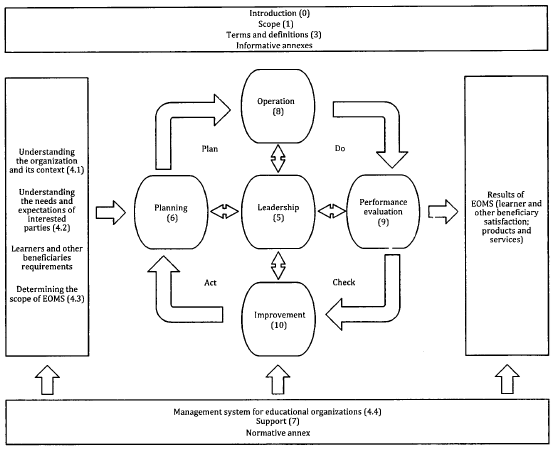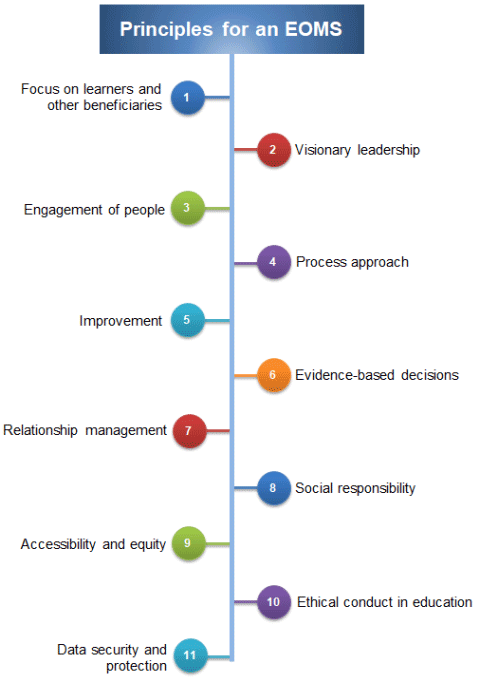ISO 21001
ISO 21001:2018 вҖ“ Educational organizations вҖ“ Management systems for educational organizations вҖ“ Requirements with guidance for use
1. Introduction
Although educational organizations and learners worldwide are the main beneficiaries of this document, all interested parties will benefit from standardized management systems in educational organizations.
EXAMPLE Employers who sponsor and encourage staff to participate in educational services can also benefit from this document.
The potential benefits to an organization of implementing a management system for educational organizations (EOMS) based on this document are:
a) better alignment of objectives and activities with policy (including mission and vision);
b) enhanced social responsibility by providing inclusive and equitable quality education for all;
c) more personalized learning and effective response to all learners and particularly to learners with special education needs, distance learners and lifelong learning opportunities;
d) consistent processes and evaluation tools to demonstrate and increase effectiveness and efficiency;
e) increased credibility of the organization;
f) a means that enables educational organizations to demonstrate their commitment to effective educational management practices;
g) a culture for organizational improvement;
h) harmonization of regional, national, open, proprietary, and other standards within an international framework;
i) widened participation of interested parties;
j) stimulation of excellence and innovation.
2. ISO 21001 structure in the Plan-Do-Check-Act cycle

<EOMS in the framework of ISO21000>
3. Principles for an EOMS
This EOMS entails the following management principles:

- Focus on learners and other beneficiaries вҖ“ The primary focus of the EOMS is to meet learner and other beneficiary requirements and to exceed their expectations.
- Visionary leadership вҖ“ Visionary leadership is to engage all learners and other beneficiaries in creating, writing, and implementing the organization mission, vision and objectives.
- Engagement of people вҖ“ It is essential for the organization that all individuals involved are competent, empowered and engaged in delivering value.
- Process approach вҖ“ Consistent and predictable results are achieved more effectively and efficiently when activities are understood and managed as interrelated processes that function as a coherent system, including input and output.
- Improvement вҖ“ Successful organizations have an ongoing focus on improvement.
- Evidence-based decisions вҖ“ Decisions and curricula based on the analysis and evaluation of data and information are more likely to produce desired results.
- Relationship management вҖ“ For sustained success, organizations manage their relationships with interested parties, such as providers.
- Social responsibility вҖ“ Socially responsible organizations are sustainable and ensure long-term success.
- Accessibility and equity вҖ“ Successful organizations are inclusive, flexible, transparent and accountable, in order to address learnersвҖҷ individual and special needs, interests, abilities and backgrounds.
- Ethical conduct in education вҖ“ Ethical conduct relates to the ability of the organization to create an ethical professional environment where all interested parties are dealt with equitably, conflicts of interests are avoided, and activities are conducted for the benefit of the society.
- Data security and protection вҖ“ The organization creates an environment where all interested parties can interact with the educational organization in full confidence that they maintain control over the use of their own data, and that the educational organization will treat their data with appropriate care and confidentiality.
4. Structure of the ISO 21001 standard
| |
HLS for ISO management Systems |
ISO21001:2018 |
| Clause 4 |
Context of the organization |
4.1 Understanding the organization and its context
4.2 Understanding the needs and expectations of interested parties
4.3 Determining the scope of the management system for educational organizations
4.4 Management system for educational organizations (EOMS) |
| Clause 5 |
Leadership |
5.1 Leadership and commitment
5.2 Policy
5.3 Organizational roles, responsibilities and authorities |
| Clause 6 |
Planning |
6.1 Actions to address risks and opportunities
6.2 Educational organization objectives and planning to achieve them
6.3 Planning of changes |
| Clause 7 |
Support |
7.1 Resources
7.2 Competence
7.3 Awareness
7.4 Communication
7.5 Documented information |
| Clause 8 |
Operation |
8.1 Operational planning and control
8.2 Requirements for the educational products and services
8.3 Design and development of the educational products and services
8.4 Control of externally provided processes, products and services
8.5 Delivery of the educational products and services
8.6 Release of the educational products and services
8.7 Control of the educational nonconforming outputs |
| Clause 9 |
Performance evaluation |
9.1 Monitoring, measurement, analysis and evaluation
9.2 Internal audit
9.3 Management review |
| Clause 10 |
Improvement |
10.1 Nonconformity and corrective action
10.2 Continual improvement
10.3 Opportunities for improvement |
|